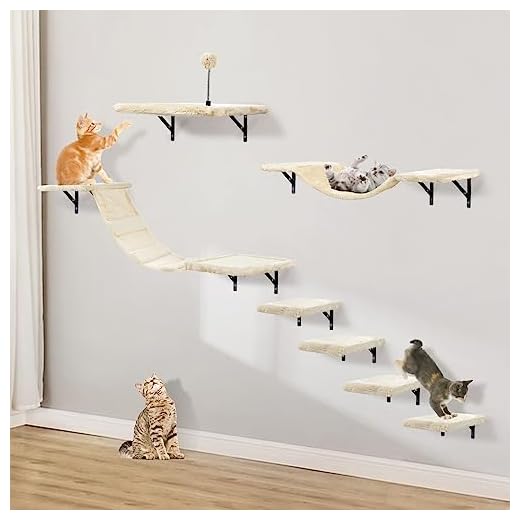



Yes, they can, and I’m living proof! As an 8-year-old Scottish Fold with my own website, I’ve seen many pairs of felines thrive together. When considering introducing a new companion, it’s crucial to focus on their personalities. A laid-back demeanor often complements a more curious nature well. This combination can lead to a peaceful coexistence.
Space is vital in those initial days. Each fluffy friend should have their own territory to retreat to, helping them feel secure. Gradually introducing them through scent swapping and short supervised interactions lays a solid foundation. Patience is key; it may take time for them to adjust to one another.
Observing body language can reveal a lot. Signs of stress or aggression, like hissing or puffing up, indicate that they need more time apart. On the other hand, playful gestures and relaxed postures signal that they are warming up to each other. I thrive on companionship, but it’s important to ensure that both parties are comfortable with the arrangement.
Compatibility Between Different Genders in Felines
Introducing a new companion to your household? A few strategies can enhance harmony between a tom and a queen. First, ensure both individuals have their own space. Separate feeding areas, litter boxes, and resting spots minimize territorial disputes.
Tips for Smooth Introductions
- Conduct a gradual introduction. Allow them to sniff each other’s belongings before meeting face-to-face.
- Supervise initial interactions. Short, controlled meetings help them adjust to each other’s presence.
- Observe body language. Signs of aggression or fear should be addressed immediately.
Health factors can impact behavior. Regular veterinary check-ups ensure both are healthy and free of issues that could lead to irritability. For instance, utilizing the best flea and tick collar for cats helps prevent discomfort from pests that can cause stress and lead to conflicts.
Establishing a Peaceful Environment
- Provide plenty of vertical space. Cats love to climb, and having separate perches can reduce tension.
- Engage them in play together. Shared activities can foster bonding over time.
- Use calming products, like pheromones, to ease any anxiety during the adjustment phase.
With time, patience, and the right approach, a harmonious coexistence is achievable. Each feline has its own personality, and understanding those traits can lead to a peaceful home.
Understanding Behavioral Differences Between Males and Females
It’s important to note that the characteristics of each kitty can vary widely, but I can share some trends I’ve observed. Typically, boys tend to be more playful and adventurous. They often engage in roughhousing and enjoy exploring their surroundings. This playful nature can lead to a more boisterous atmosphere, which might be overwhelming for some companions.
On the flip side, the ladies usually exhibit a gentler demeanor, often displaying more nurturing behaviors. They may prefer quieter environments and can be more territorial. This can sometimes manifest as a need for personal space, especially when adjusting to new friends.
Social Interactions
Interactions between different genders often highlight these behavioral traits. A playful boy might inadvertently irritate a shy girl, leading to misunderstandings. It’s helpful to introduce them gradually, allowing both to acclimate to each other’s presence. Providing separate spaces at first can ease tension and help them establish their own territories.
Affection and Bonding
When it comes to affection, males often seek attention and may be more vocal about their needs. Females, however, might show affection in subtler ways, such as slow blinks or gentle headbutts. Observing these behaviors can help you understand each one’s unique personality and facilitate a stronger bond between them.
Factors Influencing Compatibility in Mixed-Gender Cat Households
When bringing together a boy and a girl from my species, various elements play a role in their harmony. First, age matters; younger felines tend to adapt more easily than older ones. If both are still in their playful years, chances of bonding increase.
Next, personality traits significantly affect interactions. Some of us are naturally more social, while others prefer solitude. A laid-back companion often complements an energetic counterpart, leading to a peaceful coexistence.
Territorial behavior is another aspect to consider. Cats, regardless of gender, may feel threatened by newcomers. Gradual introductions can help mitigate tension. Create separate spaces for each feline initially, allowing them to familiarize themselves with each other’s scents before face-to-face meetings.
Neutering or spaying is crucial. Altered individuals typically show reduced aggression and territorial disputes, promoting a friendlier environment. It’s a simple step that can lead to smoother relationships.
Lastly, shared experiences, such as playtime or feeding, can strengthen their bond. Engaging in joint activities can help build trust and comfort between them, ultimately enhancing their living situation.
Tips for Introducing a Male and Female Cat Successfully
Start with separate spaces. Set up distinct areas for each companion, complete with food, water, litter box, and cozy resting spots. This allows them to acclimate to the new environment without feeling threatened.
Gradual Introduction
Introduce them gradually. Use a barrier such as a baby gate or cracked door to let them observe each other without direct contact. Gradually increase their exposure while monitoring their reactions for signs of stress or aggression.
Positive Reinforcement
Utilize treats and praise during interactions. Reward calm behavior with snacks and affection, reinforcing positive associations with one another. This will help them build a friendly rapport over time.
Keep playtime interactive. Engage both in joint play sessions using wand toys or laser pointers, allowing them to bond through shared activities. Monitor their body language to ensure it stays playful, not predatory.
Be patient. Allow them time to adjust at their own pace. Each individual has unique personalities, and rushing the introduction could lead to unnecessary stress and conflict. Regularly assess their comfort levels and adjust the process as needed.
Yes, they can, and I’m living proof! As an 8-year-old Scottish Fold with my own website, I’ve seen many pairs of felines thrive together. When considering introducing a new companion, it’s crucial to focus on their personalities. A laid-back demeanor often complements a more curious nature well. This combination can lead to a peaceful coexistence.
Space is vital in those initial days. Each fluffy friend should have their own territory to retreat to, helping them feel secure. Gradually introducing them through scent swapping and short supervised interactions lays a solid foundation. Patience is key; it may take time for them to adjust to one another.
Observing body language can reveal a lot. Signs of stress or aggression, like hissing or puffing up, indicate that they need more time apart. On the other hand, playful gestures and relaxed postures signal that they are warming up to each other. I thrive on companionship, but it’s important to ensure that both parties are comfortable with the arrangement.
Compatibility Between Different Genders in Felines
Introducing a new companion to your household? A few strategies can enhance harmony between a tom and a queen. First, ensure both individuals have their own space. Separate feeding areas, litter boxes, and resting spots minimize territorial disputes.
Tips for Smooth Introductions
- Conduct a gradual introduction. Allow them to sniff each other’s belongings before meeting face-to-face.
- Supervise initial interactions. Short, controlled meetings help them adjust to each other’s presence.
- Observe body language. Signs of aggression or fear should be addressed immediately.
Health factors can impact behavior. Regular veterinary check-ups ensure both are healthy and free of issues that could lead to irritability. For instance, utilizing the best flea and tick collar for cats helps prevent discomfort from pests that can cause stress and lead to conflicts.
Establishing a Peaceful Environment
- Provide plenty of vertical space. Cats love to climb, and having separate perches can reduce tension.
- Engage them in play together. Shared activities can foster bonding over time.
- Use calming products, like pheromones, to ease any anxiety during the adjustment phase.
With time, patience, and the right approach, a harmonious coexistence is achievable. Each feline has its own personality, and understanding those traits can lead to a peaceful home.
Understanding Behavioral Differences Between Males and Females
It’s important to note that the characteristics of each kitty can vary widely, but I can share some trends I’ve observed. Typically, boys tend to be more playful and adventurous. They often engage in roughhousing and enjoy exploring their surroundings. This playful nature can lead to a more boisterous atmosphere, which might be overwhelming for some companions.
On the flip side, the ladies usually exhibit a gentler demeanor, often displaying more nurturing behaviors. They may prefer quieter environments and can be more territorial. This can sometimes manifest as a need for personal space, especially when adjusting to new friends.
Social Interactions
Interactions between different genders often highlight these behavioral traits. A playful boy might inadvertently irritate a shy girl, leading to misunderstandings. It’s helpful to introduce them gradually, allowing both to acclimate to each other’s presence. Providing separate spaces at first can ease tension and help them establish their own territories.
Affection and Bonding
When it comes to affection, males often seek attention and may be more vocal about their needs. Females, however, might show affection in subtler ways, such as slow blinks or gentle headbutts. Observing these behaviors can help you understand each one’s unique personality and facilitate a stronger bond between them.
Factors Influencing Compatibility in Mixed-Gender Cat Households
When bringing together a boy and a girl from my species, various elements play a role in their harmony. First, age matters; younger felines tend to adapt more easily than older ones. If both are still in their playful years, chances of bonding increase.
Next, personality traits significantly affect interactions. Some of us are naturally more social, while others prefer solitude. A laid-back companion often complements an energetic counterpart, leading to a peaceful coexistence.
Territorial behavior is another aspect to consider. Cats, regardless of gender, may feel threatened by newcomers. Gradual introductions can help mitigate tension. Create separate spaces for each feline initially, allowing them to familiarize themselves with each other’s scents before face-to-face meetings.
Neutering or spaying is crucial. Altered individuals typically show reduced aggression and territorial disputes, promoting a friendlier environment. It’s a simple step that can lead to smoother relationships.
Lastly, shared experiences, such as playtime or feeding, can strengthen their bond. Engaging in joint activities can help build trust and comfort between them, ultimately enhancing their living situation.
Tips for Introducing a Male and Female Cat Successfully
Start with separate spaces. Set up distinct areas for each companion, complete with food, water, litter box, and cozy resting spots. This allows them to acclimate to the new environment without feeling threatened.
Gradual Introduction
Introduce them gradually. Use a barrier such as a baby gate or cracked door to let them observe each other without direct contact. Gradually increase their exposure while monitoring their reactions for signs of stress or aggression.
Positive Reinforcement
Utilize treats and praise during interactions. Reward calm behavior with snacks and affection, reinforcing positive associations with one another. This will help them build a friendly rapport over time.
Keep playtime interactive. Engage both in joint play sessions using wand toys or laser pointers, allowing them to bond through shared activities. Monitor their body language to ensure it stays playful, not predatory.
Be patient. Allow them time to adjust at their own pace. Each individual has unique personalities, and rushing the introduction could lead to unnecessary stress and conflict. Regularly assess their comfort levels and adjust the process as needed.
Yes, they can, and I’m living proof! As an 8-year-old Scottish Fold with my own website, I’ve seen many pairs of felines thrive together. When considering introducing a new companion, it’s crucial to focus on their personalities. A laid-back demeanor often complements a more curious nature well. This combination can lead to a peaceful coexistence.
Space is vital in those initial days. Each fluffy friend should have their own territory to retreat to, helping them feel secure. Gradually introducing them through scent swapping and short supervised interactions lays a solid foundation. Patience is key; it may take time for them to adjust to one another.
Observing body language can reveal a lot. Signs of stress or aggression, like hissing or puffing up, indicate that they need more time apart. On the other hand, playful gestures and relaxed postures signal that they are warming up to each other. I thrive on companionship, but it’s important to ensure that both parties are comfortable with the arrangement.
Compatibility Between Different Genders in Felines
Introducing a new companion to your household? A few strategies can enhance harmony between a tom and a queen. First, ensure both individuals have their own space. Separate feeding areas, litter boxes, and resting spots minimize territorial disputes.
Tips for Smooth Introductions
- Conduct a gradual introduction. Allow them to sniff each other’s belongings before meeting face-to-face.
- Supervise initial interactions. Short, controlled meetings help them adjust to each other’s presence.
- Observe body language. Signs of aggression or fear should be addressed immediately.
Health factors can impact behavior. Regular veterinary check-ups ensure both are healthy and free of issues that could lead to irritability. For instance, utilizing the best flea and tick collar for cats helps prevent discomfort from pests that can cause stress and lead to conflicts.
Establishing a Peaceful Environment
- Provide plenty of vertical space. Cats love to climb, and having separate perches can reduce tension.
- Engage them in play together. Shared activities can foster bonding over time.
- Use calming products, like pheromones, to ease any anxiety during the adjustment phase.
With time, patience, and the right approach, a harmonious coexistence is achievable. Each feline has its own personality, and understanding those traits can lead to a peaceful home.
Understanding Behavioral Differences Between Males and Females
It’s important to note that the characteristics of each kitty can vary widely, but I can share some trends I’ve observed. Typically, boys tend to be more playful and adventurous. They often engage in roughhousing and enjoy exploring their surroundings. This playful nature can lead to a more boisterous atmosphere, which might be overwhelming for some companions.
On the flip side, the ladies usually exhibit a gentler demeanor, often displaying more nurturing behaviors. They may prefer quieter environments and can be more territorial. This can sometimes manifest as a need for personal space, especially when adjusting to new friends.
Social Interactions
Interactions between different genders often highlight these behavioral traits. A playful boy might inadvertently irritate a shy girl, leading to misunderstandings. It’s helpful to introduce them gradually, allowing both to acclimate to each other’s presence. Providing separate spaces at first can ease tension and help them establish their own territories.
Affection and Bonding
When it comes to affection, males often seek attention and may be more vocal about their needs. Females, however, might show affection in subtler ways, such as slow blinks or gentle headbutts. Observing these behaviors can help you understand each one’s unique personality and facilitate a stronger bond between them.
Factors Influencing Compatibility in Mixed-Gender Cat Households
When bringing together a boy and a girl from my species, various elements play a role in their harmony. First, age matters; younger felines tend to adapt more easily than older ones. If both are still in their playful years, chances of bonding increase.
Next, personality traits significantly affect interactions. Some of us are naturally more social, while others prefer solitude. A laid-back companion often complements an energetic counterpart, leading to a peaceful coexistence.
Territorial behavior is another aspect to consider. Cats, regardless of gender, may feel threatened by newcomers. Gradual introductions can help mitigate tension. Create separate spaces for each feline initially, allowing them to familiarize themselves with each other’s scents before face-to-face meetings.
Neutering or spaying is crucial. Altered individuals typically show reduced aggression and territorial disputes, promoting a friendlier environment. It’s a simple step that can lead to smoother relationships.
Lastly, shared experiences, such as playtime or feeding, can strengthen their bond. Engaging in joint activities can help build trust and comfort between them, ultimately enhancing their living situation.
Tips for Introducing a Male and Female Cat Successfully
Start with separate spaces. Set up distinct areas for each companion, complete with food, water, litter box, and cozy resting spots. This allows them to acclimate to the new environment without feeling threatened.
Gradual Introduction
Introduce them gradually. Use a barrier such as a baby gate or cracked door to let them observe each other without direct contact. Gradually increase their exposure while monitoring their reactions for signs of stress or aggression.
Positive Reinforcement
Utilize treats and praise during interactions. Reward calm behavior with snacks and affection, reinforcing positive associations with one another. This will help them build a friendly rapport over time.
Keep playtime interactive. Engage both in joint play sessions using wand toys or laser pointers, allowing them to bond through shared activities. Monitor their body language to ensure it stays playful, not predatory.
Be patient. Allow them time to adjust at their own pace. Each individual has unique personalities, and rushing the introduction could lead to unnecessary stress and conflict. Regularly assess their comfort levels and adjust the process as needed.









